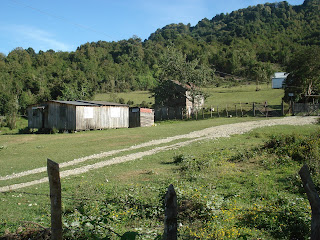Summer, early January 2012
(Click on photos to enlarge)
(Click on photos to enlarge)
The town of Cochamó is on the Reloncaví fjord, less than
three hours by bus from Puerto Montt. Before the gravel road was built in the late 1970s, the only access was by an 8-hour trip by boat. For the past 120 years local people brought their cattle to town to await boats that took them to market in Puerto Montt. Some would drive their animals down the mountains from nearby Argentina.
The road has made it possible to create salmon farms and a shellfish industry, providing many jobs and a population explosion. There are about 5,000 people here now. The ancient wooden church is built in the Chilote style and commands a great view of the fjord and the impressive Yates volcano. I had been in the area a few times in the past several years, but never stayed in the town. Simple accommodations and meals are available for the traveler. This is also where one organizes horse pack trips to the mountains. There are a few outfitters and guides available.
The road has made it possible to create salmon farms and a shellfish industry, providing many jobs and a population explosion. There are about 5,000 people here now. The ancient wooden church is built in the Chilote style and commands a great view of the fjord and the impressive Yates volcano. I had been in the area a few times in the past several years, but never stayed in the town. Simple accommodations and meals are available for the traveler. This is also where one organizes horse pack trips to the mountains. There are a few outfitters and guides available.
The rural bus from Puerto Montt was full of locals and tourists alike, and let me off at the bed and breakfast run by Señora Gladys, an
enterprising woman who offers rooms and meals. Within five minutes of my
arrival she asked if I was interested in a horse trip. When I replied yes, she
called “Ivan” and her brother appeared and we began planning a trip in the next two
days.
The views from the town are spectacular in every direction. My first two days here were warm and clear, with temps in the mid to upper 70s. This is a view from one family's front yard. On the upper right
is a clothesline. The other dots represent the local shellfish farm, primarily
mussels, in the fjord. Crab and sea urchins are available in season also, but not in summertime.
Reloncaví fjord at Cochamó. Yates volcano in the background was named for the Englishman John Yates who was a local ship pilot in the early 19th century.
The mountains and fjord surround the town.
Cochamó Valley is a few kilometers up in the mountains, and is fast becoming a tourist attraction for hikers and rock climbers. I was last here in 2002 when tourism was only beginning in the valley. It's not easy to get there. A treacherous horse trail goes through the dark forest. One can hire a horse and guide, or make the slog by foot. By horse it is about four hours, following a track that has worn down over the decades. The heavy rainfall causes the trail to erode, and horses and people must clamber over rocks and mud. Those conditions precluded my taking any photos along the trail. I was too busy keeping my balance and helping the horse choose the best part of the trail to follow. Ivan was my guide. In the last 10 years a new refugio hut has been built with a large bunk room. An American/Argentine family provides delicious vegetarian meals and a delightful place to pass the time between hikes. It's called Refugio Cochamó. The hazy and cloudy conditions meant I couldn't get good photos here either, so here are some from my last visit, when I stayed at the nearby refugio of Campo Aventura, a local outfitter.
The valley is touted as the Chilean Yosemite. One feels surrounded by multiple El Capitán mountains. In 2002 there were about six people in the valley. In 2012 there were dozens, mostly campers who come to have new climbing experiences. I think I was the only person over age 40.
After two nights in the refugio, Ivan returned with the horses to guide me back to town. That is when the rain began to drizzle, and it didn't let up for the next four hours. I arrived at the BandB in time for a hot shellfish stew. The next day the rains became torrential, and there were people who were on the trail on horse or on foot, some with heavy backpacks. Such is the life in much of Chilean Patagonia.












No comments:
Post a Comment